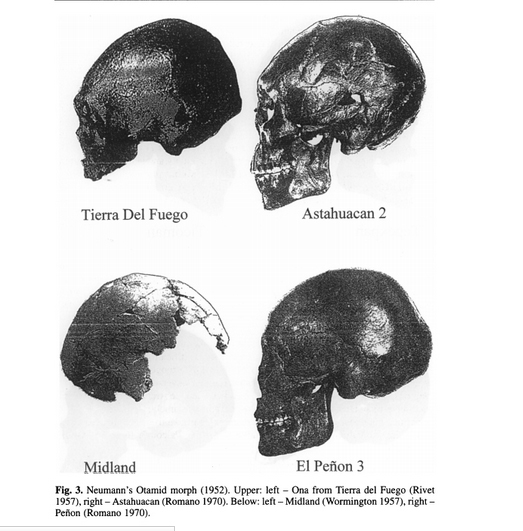| Online: | |
| Visits: | |
| Stories: |

| Story Views | |
| Now: | |
| Last Hour: | |
| Last 24 Hours: | |
| Total: | |
How Long Have Humans Been In America?
(Above: Slope-headed “Otamid” skull found in Humboldt Sink near Lovelock Cave – see my post on slope-headed ones)
Some of researchers' estimations on what they find go back 20,000 to 30,000 years ago and perhaps beyond. It was generally accepted by those who believe in the land bridge theory, that homo sapiens did not arrive in America until perhaps 11,000 years ago the lastest – following ice receding. It would appear that either they are uncomfortable with an earlier man here in the Americas because of views that it didn't open until until man could walk here or they have been concentrating on things like Aztecs, Incas and Mayans and not wanting to look at older finds.
Researchers found the Yaghan Indians of Tiera Del Fuego way at the tip of Argentina to the extreme south, had the Otamid skulls and no Halotype A or B DNA as found in Amerind people (second migration). Given their physical characteristics and the Argentinian finds of these “primitive” looking people (this reference by early researchers caused a bottleneck of new thought on these finds) one can assume that the two were likely related.
Let me give you a taste of this odd type which was referred to as Homo Sapiens Pampaeus (or Americanus):
Overview of Paleoindian Taxonomy and Migration Hypothesesby Mario Pichardo
“Cranial deformation (Early Man in South America – page 300) among savages is a ritual operation denoting contact of peoples...agrees with Professor Ameghino's `first representation of the human beings,' if not even man's forerunner, Homo pampaeus.” (in other words, they were emulating these original ones)
Carlos Ameghino (who studied the earliest South American finds – page 309) said that the 3 skulls found in Pampean formation “Necochea” were the same age as the Miramar skull and what he calls homo pampaeus which has excessively sloping forehead, which is natural and not the result of deformation, very doliocephalic, with excessively narrow foreheads, great orbits and other characteristics....” and “…the conformation of the frontal region is natural without any vestige of artificial deformation; on this point, there cannot remain absolutely the slightest doubt....
One parting note – researchers are very confused at old research (1800s/early 1900s) and standards for archaeology and anthropology and all these things that are “out of place/time” compared to what they were told in school. Many researchers refused to believe time periods of finds and had limited knowledge of aging items. If they found something that seemed older than what they believed technology to be, then they dismissed it as an aberration or invalid evidence.
Here's an example -
Amazing finds blow researchers minds (website)
The evidence for earlier human habitation in the Americas, however scanty, is tantalizing. It includes:
|
|
- A possible handscraper splotched with blood more than 34,000 years ago at Monte Verde in Chile.
- Possible stone tools at a site in Brazil that is 40,000 to 50,000 years old.
- A not-yet-published report of human remains dated as much as 28,000 years old near Puebla in central Mexico.
– Most crucially, a majority of archaeologists are convinced that a second site at Monte Verde dates to at least 14,000 years ago – some 500 years before the land bridge from Asia opened more than 9,000 miles to the north.
Yet the early dates are still often questioned.
A claim of 250,000-year-old human tools near Mexico's Valsequillo reservoir was widely laughed at in the 1970s, though other researchers are once again working at that area…
Solorzano, 83, is a respected researcher who has taught generations of university students in the city of Guadalajara. His home office holds a cabinet full of bones – some of them human – topped by 14 realistic models of hominid skulls.
He says the brow bone raises “many questions, one of them being its great and amazing resemblance to primitive hominid forms whose presence in the Americas has not been generally accepted.”
The few other scientists who have analyzed the bones closely agree that they look human – not animal – and are very, very old. “They were definitely human,” said Joel Irish, a specialist in bioarchaeology at the University of Alaska, Fairbanks.
He suggested they could be from “a very primitive looking modern human,” but said they would be “very early.”
The First American: The Suppressed Story of the People Who Discovered the New World by Christopher Hardaker (book)
Early Man in South America by Alex Hrdlicka (book)
Pericue Indians of Baja (website)
Forbidden Archaeology (website)
The First Americans, Race, Evolution, and the Origin of Native Americans by Joseph F. Powell (book)
Source: http://www.ghosthuntingtheories.com/2014/04/how-long-have-humans-been-in-america.html





